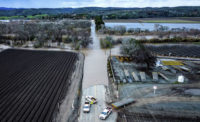...experienced in Haiti from the Jan. 12 earthquake there. That magnitude-7 quake, the epicenter of which was close to the surface under a densely populated urban area, killed more than 220,000 people and left more than one million homeless.
While the Chile earthquake was more than 500 times more powerful than the one that struck Haiti, there were a number of critical differences between the two disasters, says Paul Caruso, a geophysicist with the U.S. Geological Survey in Golden, Colo. “In this case it may not be as much of the mechanism as the location of the epicenter and depth of the event itself,” he says. The earthquake in Haiti occurred at a depth of 13 km and struck almost precisely beneath the country’s largest populated area, the capitol of Port-au-Prince, while Chile’s quake was 35 km deep and centered offshore, more than 100 miles from the nearest major metropolitan area.
But the most important difference between the two disasters was the degree of preparedness, officials say.
Haiti’s penultimate major seismic event occurred almost two and a half centuries ago. In Chile, temblors are common, and many still remember the devastation wrought by the quake of 1960, which struck the same area as Saturday’s quake. That magnitude-9.5 quake claimed 1,655 lives and left more than two million people homeless.
In the wake of that disaster, Chilean officials adopted numerous changes in construction practices and building codes to protect against seismic events. Concrete standards were elevated—a measure of particular importance in a country where the material is the predominant residential construction material.
Those efforts were tested on March 3, 1985, when a magnitude-7.7 earthquake hit in the same region. It claimed 177 lives and caused more than $1 billion in damage.
Much of the damage from that event occurred to buildings that had been constructed prior to the changes in construction practices. In Santiago, a number of the city’s churches and public buildings—including the city hall that was built in the 1950s—were severely damaged or collapsed completely.
“One big thing we noticed after the 1985 quake was that most of the damage occurred to buildings with unreinforced masonry design,” Alarcón said. “The code was updated to take account for that.”
Despite the devastation, the performance of the country’s newer buildings was seen as a success, and Chile continued to refine its seismic building-code provisions. There were substantial changes to the codes in 1993 and 1996 to reflect further improvements in anti-seismic design. The standards for concrete building construction were brought in line with American Concrete Institute standards.
Still, adobe remains a popular building material among the poorest people of Chile, despite its notorious inability to handle seismic events. According to the government, the majority of homes destroyed in the Feb. 27 quake were adobe structures located in rural areas.



Post a comment to this article
Report Abusive Comment